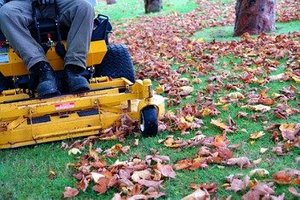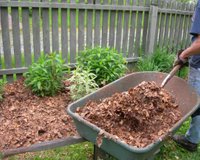Mulching
What is Leaf Mulching
Leaf mulching is the practice of chopping leaves into small pieces. Mulching can be done with a lawn mower or a leaf shredder.
Mulched leaves can be left on the lawn (they fall between the grass blades) or piled 3" or 4" deep on garden beds and around shrubs where they act as a protective layer in the winter and, in the growing season, prevent weed growth and help conserve water. Leaf mulch decomposes over time (natural composting) adding important nutrients and structure to the soil
The small pieces of leaf material that is left on the lawn after a deep pile has been mulched can be raked or blown around shrubs or simply redistributed around the lawn to slowly decompose and feed the soil. Mulched leaves reduce in volume more than 10-fold..
Mulch-mowing can be done by commercial landscapers with relatively inexpensive mulching tools.
Ensure that your mower blades are sharp.

Mulching Equipment
Mulching blades, also known as 3-in-1 blades, are designed with a greater curved surface, and often have several or longer cutting surfaces along the edges. This allows the grass to recirculate beneath the deck to be cut several times. The resulting smaller grass clippings are ideal for mulch, as they will decompose faster into the soil.
Types:
Standard Mulching Blades
Gator Mulching Blades (G3, G5, G6)
Gator blades are designed with angled teeth on each end of the blade. The teeth are angled toward the center of the blade, which guide the grass to the cutting edge over and over again.
How to Leaf Mulch?
Be sure the fallen leaves are dry. Wet leaves will not chop up as much as they need to and can create more of a headache in the form of a clogged mower and messy lawn.
Skip the raking! Leaves should be left in place. You can mulch up to 6” of dry leaves at any one time, though the less accumulation the few passes you will have to take to complete the mulching process. If there is a thick accumulation of leaves you may have to go over the area 3 or 4 times to adequately chop them up.
Be certain the leaves are chopped up sufficiently. If you can see a consistent canopy of the green grass then you are in good shape. You can chop up leaf-piles much thicker than 6” but if you notice them covering the canopy of the turf you may have to rake and remove or spread them out more to adequately chop them up.
If you are in heavily wooded area this may involve having to mow your lawn up to 2 times per week to stay ahead of them but it is quicker and easier than raking and putting into bags to remove.
Oak leaves fall much later than maple leaves and other species. If you have oak trees, you may be out mowing your lawn in the middle of January but you’ll still be recycling the nutrients back into the lawn, so its worth it!
Research has shown that mowing leaves can actually aid in an earlier spring green up and in fewer winter annuals, crabgrass, and broadleaf weeds, because the leaves act as a mulch essentially shading the soil from light reducing germinating weeds.

Leaf Mulch for Garden Beds
If there is a too thick of an accumulation of leaves, they may have to be raked into piles but can still be used as valuable mulch in your flower and garden beds, recycled at a nearby composting landfill facility, or piled up an used as a compost for later use.
